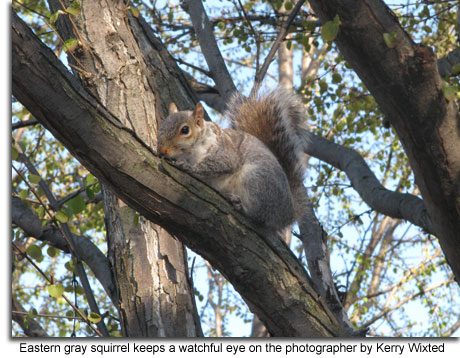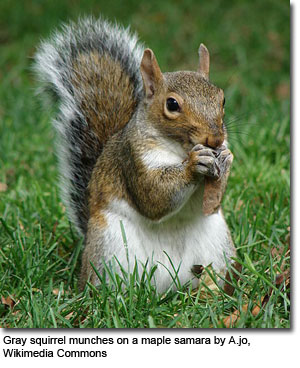Eastern Gray Squirrel
(Sciurus carolinensis)
Description and Range:
The eastern gray squirrel is one of the most common squirrels in Maryland. Gray squirrels are bushy tailed rodents with a mixture of brown, black, and white fur which when viewed from a distance blend together to look gray. Their belly fur is white or light gray. The tail is flattened, bushy and gray with silvery-tipped hairs. Some gray squirrels may be black, white or blond in color. These color morphs can be common in some locales. Gray squirrels are typically 16-20 inches in length, and they can weigh up to 1.5 pounds.

Gray squirrels can be found throughout the eastern United States, ranging from southern Quebec, New Brunswick and Ontario to Florida, west into eastern Texas, and north into southern Manitoba. This species has also been introduced to many locations outside of its native range including Washington and British Columbia. Eastern gray squirrels can be found in every county in Maryland.
Habitat:
Gray squirrels generally are found in mixed hardwood forests as well as in suburban and urban areas. The trees most commonly used by gray squirrels are white oak, American beech, American elm, red maple and sweet gum. Gray squirrels will use old woodpecker holes or natural tree cavities as dens to live in and raise young. Eastern gray squirrels will also build large nests composed of leaves and twigs. Generally, dens are made at least 20 feet off the ground. Gray squirrels are often social and will share their nests with other gray squirrels during certain times of the year.
Diet:
The diet of gray squirrels typically includes an assortment of seeds, nuts and berries such as acorns, hickory nuts, walnuts, beechnuts, pine seeds, maple samaras, wild grapes, and American holly berries. In the spring, gray squirrels will also feed on buds of maple, tulip popular, flowering dogwood and black cherry.
When their typical food is scarce, eastern gray squirrels will also consume insects (adults and larvae), juvenile birds, bird eggs and amphibians. At the end of the summer, gray squirrels will store seeds and nuts to feed on when food is scarce during the winter months.

Reproduction:
Eastern gray squirrels males reach breeding age at 9-11 months and females are about to breed around 6-8 months of age. After that, the eastern gray squirrel mates twice a year from December to February and from May to June. A mating "chase" is often involved, with several males following a female as she moves about during the day. Gray squirrels are polygamous, with one male mating with several females. After mating, gestation takes around 40-45 days.
Eastern gray squirrel litters range from 2-6 young that are born hairless and helpless. Frequently, the spring litter of young is born in a tree cavity, while the second, late-summer litter is born in a leaf nest. Females often move their litters back and forth between cavity dens and leaf nests, generally to escape predation or parasite infestation as well as due to weather changes. The young are weaned in about 50 days. Typically, gray squirrels have 2 litters per year. The second litter stays with the female over the winter.
Sounds:
Gray squirrels are quite vocal. The most familiar sound they make is a bark. Buzzing, wailing, squealing, trills, squeaks, and purrs are other common squirrel sounds.
Behavior:
The eastern gray squirrel is most active during the day and can be seen all year, even digging through snow in intense cold to retrieve buried nuts. The squirrels can make hundreds of caches. Most nuts are buried at the surface, with few more than 1/4 inch below the ground. About 85 % of the nuts may be recovered, while the remainder occasionally germinates. The gray squirrel can smell buried nuts under a foot of snow; when snow is deep, the squirrel tunnels under it to get closer to the scent.
Eastern gray squirrels typically live up to 3 years in the wild, though some wild squirrels have been found to reach the ripe age of 13.
Management:
If you are interested in attracting squirrels to your backyard while minimizing potential conflicts, then
click here for the Squirrels in Maryland page. However, gray squirrels can cause damage to backyard plantings, bird feeders and can get indoors. If you are having problems with gray squirrels, then you should
click here for the Wildlife Problems Webpage or call the nuisance wildlife hotline at 1-877-463-6497.
Gray squirrels are managed as small game species in Maryland. To learn more about small game management, then
click here.
Did you know?
The conspicuous bushy tail of the gray squirrel has many uses. It is used for balance, for heat, as an umbrella, for communication and as a rudder when swimming.
For more information, please contact:
Maryland Department of Natural Resources
Wildlife and Heritage Service
Tawes State Office Building, E-1
Annapolis MD 21401
410-260-8540
Toll-free in Maryland: 1-877-620-8DNR
[email protected]